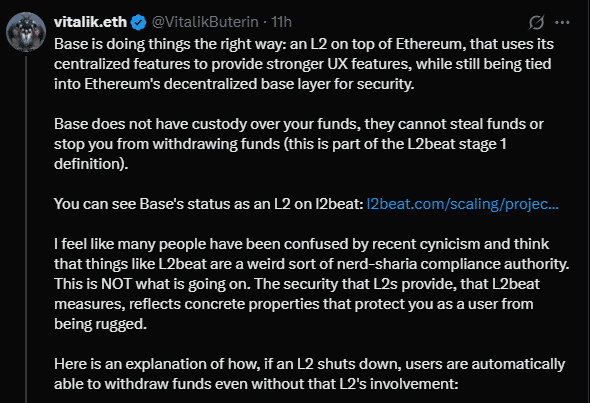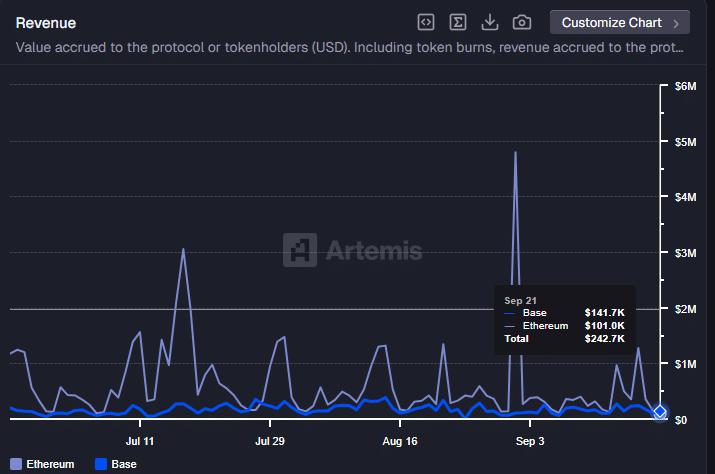| COINOTAG recommends • Exchange signup |
| 💹 Trade with pro tools |
| Fast execution, robust charts, clean risk controls. |
| 👉 Open account → |
| COINOTAG recommends • Exchange signup |
| 🚀 Smooth orders, clear control |
| Advanced order types and market depth in one view. |
| 👉 Create account → |
| COINOTAG recommends • Exchange signup |
| 📈 Clarity in volatile markets |
| Plan entries & exits, manage positions with discipline. |
| 👉 Sign up → |
| COINOTAG recommends • Exchange signup |
| ⚡ Speed, depth, reliability |
| Execute confidently when timing matters. |
| 👉 Open account → |
| COINOTAG recommends • Exchange signup |
| 🧭 A focused workflow for traders |
| Alerts, watchlists, and a repeatable process. |
| 👉 Get started → |
| COINOTAG recommends • Exchange signup |
| ✅ Data‑driven decisions |
| Focus on process—not noise. |
| 👉 Sign up → |
Vitalik Buterin says Base, a Coinbase-operated Layer 2 (L2), is a non-custodial “stage 1” rollup that cannot steal user funds. Base settles on Ethereum and allows withdrawals to the mainnet, meaning a centralized sequencer does not equate to custodial control of user assets.
-
Base is a Layer 2 rollup with on-chain settlement on Ethereum, enabling user withdrawals to the mainnet.
-
Critics point to a centralized sequencer and governance powers; proponents highlight non-custodial withdrawal guarantees.
-
Base TVL rose ~10x since early 2024 to nearly $5B, while recent fee and revenue metrics show L2 outperformance versus L1.
Base Layer 2 defended by Vitalik Buterin: Base is non-custodial and allows mainnet withdrawals — read latest facts, TVL data and expert views. Learn more.
What is Base Layer 2?
Base Layer 2 is a rollup-style Ethereum L2 designed for low-cost transactions and on-chain settlement on Ethereum. It uses a sequencer for transaction ordering but, as Vitalik Buterin emphasizes, remains non-custodial: users can exit to the Ethereum mainnet if the L2 becomes unavailable.
| COINOTAG recommends • Professional traders group |
| 💎 Join a professional trading community |
| Work with senior traders, research‑backed setups, and risk‑first frameworks. |
| 👉 Join the group → |
| COINOTAG recommends • Professional traders group |
| 📊 Transparent performance, real process |
| Spot strategies with documented months of triple‑digit runs during strong trends; futures plans use defined R:R and sizing. |
| 👉 Get access → |
| COINOTAG recommends • Professional traders group |
| 🧭 Research → Plan → Execute |
| Daily levels, watchlists, and post‑trade reviews to build consistency. |
| 👉 Join now → |
| COINOTAG recommends • Professional traders group |
| 🛡️ Risk comes first |
| Sizing methods, invalidation rules, and R‑multiples baked into every plan. |
| 👉 Start today → |
| COINOTAG recommends • Professional traders group |
| 🧠 Learn the “why” behind each trade |
| Live breakdowns, playbooks, and framework‑first education. |
| 👉 Join the group → |
| COINOTAG recommends • Professional traders group |
| 🚀 Insider • APEX • INNER CIRCLE |
| Choose the depth you need—tools, coaching, and member rooms. |
| 👉 Explore tiers → |
Why did Vitalik Buterin defend Base?
Buterin addressed claims that Base functions as an “unregistered securities exchange” or could “rug” users. He clarified that Base does not hold custody over users’ funds and that its security model is anchored to Ethereum’s settlement guarantees. This means assets locked on Base remain withdrawable to the L1 under the rollup model.
| COINOTAG recommends • Exchange signup |
| 📈 Clear interface, precise orders |
| Sharp entries & exits with actionable alerts. |
| 👉 Create free account → |
| COINOTAG recommends • Exchange signup |
| 🧠 Smarter tools. Better decisions. |
| Depth analytics and risk features in one view. |
| 👉 Sign up → |
| COINOTAG recommends • Exchange signup |
| 🎯 Take control of entries & exits |
| Set alerts, define stops, execute consistently. |
| 👉 Open account → |
| COINOTAG recommends • Exchange signup |
| 🛠️ From idea to execution |
| Turn setups into plans with practical order types. |
| 👉 Join now → |
| COINOTAG recommends • Exchange signup |
| 📋 Trade your plan |
| Watchlists and routing that support focus. |
| 👉 Get started → |
| COINOTAG recommends • Exchange signup |
| 📊 Precision without the noise |
| Data‑first workflows for active traders. |
| 👉 Sign up → |
How does Base protect user funds if the sequencer is centralized?
Base protects funds through on-chain settlement and withdrawal mechanisms to Ethereum. Even with a centralized sequencer, the rollup’s state can be verified and funds withdrawn on-chain if the sequencer stops responding. This withdrawal guarantee is the core reason some experts classify Base as a non-custodial, stage-1 L2.
What are the main criticisms of Base?
Critics focus on sequencer centralization and governance override risks. Observers warn that security councils or multisig powers could freeze or delay withdrawals in practice, even if the protocol allows eventual exits. These concerns center on operational centralization rather than the cryptographic withdrawal guarantees.
| COINOTAG recommends • Traders club |
| ⚡ Futures with discipline |
| Defined R:R, pre‑set invalidation, execution checklists. |
| 👉 Join the club → |
| COINOTAG recommends • Traders club |
| 🎯 Spot strategies that compound |
| Momentum & accumulation frameworks managed with clear risk. |
| 👉 Get access → |
| COINOTAG recommends • Traders club |
| 🏛️ APEX tier for serious traders |
| Deep dives, analyst Q&A, and accountability sprints. |
| 👉 Explore APEX → |
| COINOTAG recommends • Traders club |
| 📈 Real‑time market structure |
| Key levels, liquidity zones, and actionable context. |
| 👉 Join now → |
| COINOTAG recommends • Traders club |
| 🔔 Smart alerts, not noise |
| Context‑rich notifications tied to plans and risk—never hype. |
| 👉 Get access → |
| COINOTAG recommends • Traders club |
| 🤝 Peer review & coaching |
| Hands‑on feedback that sharpens execution and risk control. |
| 👉 Join the club → |
Vitalik noted that certain voting powers remain outside L2 councils in some rollups, which strengthens non-custodial claims. Still, debates continue on whether governance constructs and emergency powers introduce practical custody risks.

Source: X
The debate continues — what did supporters and critics say?
Supporters argue that Base aligns with Ethereum’s L2 security model: cryptographic proofs and the ability to withdraw to L1 are fundamental safeguards. Max Resnick and others recommend targeted regulation at sequencing layers, not blanket claims of custodial exchange status.
| COINOTAG recommends • Exchange signup |
| 📈 Clear control for futures |
| Sizing, stops, and scenario planning tools. |
| 👉 Open futures account → |
| COINOTAG recommends • Exchange signup |
| 🧩 Structure your futures trades |
| Define entries & exits with advanced orders. |
| 👉 Sign up → |
| COINOTAG recommends • Exchange signup |
| 🛡️ Control volatility |
| Automate alerts and manage positions with discipline. |
| 👉 Get started → |
| COINOTAG recommends • Exchange signup |
| ⚙️ Execution you can rely on |
| Fast routing and meaningful depth insights. |
| 👉 Create account → |
| COINOTAG recommends • Exchange signup |
| 📒 Plan. Execute. Review. |
| Frameworks for consistent decision‑making. |
| 👉 Join now → |
| COINOTAG recommends • Exchange signup |
| 🧩 Choose clarity over complexity |
| Actionable, pro‑grade tools—no fluff. |
| 👉 Open account → |
Critics counter that real-world governance decisions can delay or block user access. Joseph Lubin and some protocol researchers warn that divergence from the mainnet roadmap or excessive central control could create systemic risk.
When was Base launched and how fast has it grown?
Base launched in August 2023 as Coinbase’s low-cost L2 for on-chain products. Since early 2024, Total Value Locked (TVL) has grown roughly 10x from ~$500 million to nearly $5 billion.
| COINOTAG recommends • Members‑only research |
| 📌 Curated setups, clearly explained |
| Entry, invalidation, targets, and R:R defined before execution. |
| 👉 Get access → |
| COINOTAG recommends • Members‑only research |
| 🧠 Data‑led decision making |
| Technical + flow + context synthesized into actionable plans. |
| 👉 Join now → |
| COINOTAG recommends • Members‑only research |
| 🧱 Consistency over hype |
| Repeatable rules, realistic expectations, and a calmer mindset. |
| 👉 Get access → |
| COINOTAG recommends • Members‑only research |
| 🕒 Patience is an edge |
| Wait for confirmation and manage risk with checklists. |
| 👉 Join now → |
| COINOTAG recommends • Members‑only research |
| 💼 Professional mentorship |
| Guidance from seasoned traders and structured feedback loops. |
| 👉 Get access → |
| COINOTAG recommends • Members‑only research |
| 🧮 Track • Review • Improve |
| Documented PnL tracking and post‑mortems to accelerate learning. |
| 👉 Join now → |
Recent metrics show Base outpacing the Ethereum mainnet in fees and revenues over the last quarter: fees increased ~4% to $146K with revenue around $141.7K, while L1 revenue fell significantly year-over-year.

| COINOTAG recommends • Exchange signup |
| 🎯 Focus on process over noise |
| Plan trades, size positions, execute consistently. |
| 👉 Sign up → |
| COINOTAG recommends • Exchange signup |
| 🛠️ Simplify execution |
| Keep decisions clear with practical controls. |
| 👉 Get started → |
| COINOTAG recommends • Exchange signup |
| 📊 Make data your edge |
| Use depth and alerts to avoid guesswork. |
| 👉 Open account → |
| COINOTAG recommends • Exchange signup |
| 🧭 Be prepared, not reactive |
| Turn setups into rules before you trade. |
| 👉 Create account → |
| COINOTAG recommends • Exchange signup |
| ✍️ Plan first, then act |
| Entries, exits, and reviews that fit your routine. |
| 👉 Join now → |
| COINOTAG recommends • Exchange signup |
| 🧩 Consistency beats intensity |
| Small, repeatable steps win the long run. |
| 👉 Sign up → |
Source: Artemis
How will Base evolve toward decentralization?
Base’s team, led by Jesse Pollak, has publicly committed to moving toward a “stage 2” decentralization roadmap. This includes plans to decentralize block production and broaden governance participation. Those steps would reduce operational centralization while preserving withdrawal guarantees.
| COINOTAG recommends • Premium trading community |
| 🏛️ WAGMI CAPITAL — Premium Trading Community |
| Strategic insights, exclusive opportunities, professional support. |
| 👉 Join WAGMI CAPITAL → |
| COINOTAG recommends • Premium trading community |
| 💬 Inner Circle access |
| See members share real‑time PnL and execution notes in chat. |
| 👉 Apply for Inner Circle → |
| COINOTAG recommends • Premium trading community |
| 🧩 Turn theses into trades |
| Reusable templates for entries, risk, and review—end to end. |
| 👉 Join the club → |
| COINOTAG recommends • Premium trading community |
| 💡 Long‑term mindset |
| Patience and discipline over noise; a process that compounds. |
| 👉 Get started → |
| COINOTAG recommends • Premium trading community |
| 📚 Education + execution |
| Courses, playbooks, and live market walkthroughs—learn by doing. |
| 👉 Get access → |
| COINOTAG recommends • Premium trading community |
| 🔒 Members‑only research drops |
| Curated analyses and private briefings—quality over quantity. |
| 👉 Join WAGMI CAPITAL → |
Frequently Asked Questions
Can Base steal user funds?
No. Base is non-custodial in design: users retain cryptographic ability to withdraw funds to the Ethereum mainnet, preventing sequencer operators from permanently stealing assets.
| COINOTAG recommends • Exchange signup |
| 🧱 Execute with discipline |
| Watchlists, alerts, and flexible order control. |
| 👉 Sign up → |
| COINOTAG recommends • Exchange signup |
| 🧩 Keep your strategy simple |
| Clear rules and repeatable steps. |
| 👉 Open account → |
| COINOTAG recommends • Exchange signup |
| 🧠 Stay objective |
| Let data—not emotion—drive actions. |
| 👉 Get started → |
| COINOTAG recommends • Exchange signup |
| ⏱️ Trade when it makes sense |
| Your plan sets the timing—not the feed. |
| 👉 Join now → |
| COINOTAG recommends • Exchange signup |
| 🌿 A calm plan for busy markets |
| Set size and stops first, then execute. |
| 👉 Create account → |
| COINOTAG recommends • Exchange signup |
| 🧱 Your framework. Your rules. |
| Design entries/exits that fit your routine. |
| 👉 Sign up → |
Is Base centralized because Coinbase operates the sequencer?
Sequencer operation by Coinbase is an operational centralization point, but not necessarily custodial custody. Centralization risks remain a governance and operational consideration, not an automatic loss of user withdrawal guarantees.
Key Takeaways
- Non-custodial design: Base’s settlement on Ethereum enables user withdrawals, limiting custodian risk.
- Operational centralization risk: Sequencer and governance powers raise practical concerns that merit technical and regulatory attention.
- Growth and roadmap: Base’s rapid TVL and revenue growth are driving a roadmap toward greater decentralization (stage 2).
Conclusion
Vitalik Buterin’s defense of Base underscores a key distinction: sequencer centralization does not automatically equal custody over user assets. Base remains a Layer 2 rollup with withdrawal guarantees to Ethereum, and its team has signaled plans to decentralize further. Watch for stage-2 milestones and governance changes as the best indicators of long-term risk reduction.
| COINOTAG recommends • Members‑only research |
| 📌 Curated setups, clearly explained |
| Entry, invalidation, targets, and R:R defined before execution. |
| 👉 Get access → |
| COINOTAG recommends • Members‑only research |
| 🧠 Data‑led decision making |
| Technical + flow + context synthesized into actionable plans. |
| 👉 Join now → |
| COINOTAG recommends • Members‑only research |
| 🧱 Consistency over hype |
| Repeatable rules, realistic expectations, and a calmer mindset. |
| 👉 Get access → |
| COINOTAG recommends • Members‑only research |
| 🕒 Patience is an edge |
| Wait for confirmation and manage risk with checklists. |
| 👉 Join now → |
| COINOTAG recommends • Members‑only research |
| 💼 Professional mentorship |
| Guidance from seasoned traders and structured feedback loops. |
| 👉 Get access → |
| COINOTAG recommends • Members‑only research |
| 🧮 Track • Review • Improve |
| Documented PnL tracking and post‑mortems to accelerate learning. |
| 👉 Join now → |









